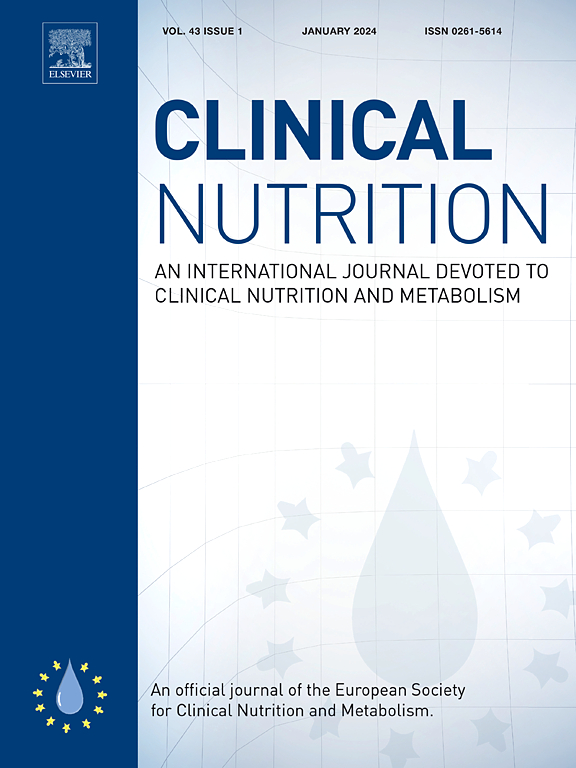中链甘油三酯补充与胆道闭锁婴儿生长、营养状况和临床结局的关系
IF 6.6
2区 医学
Q1 NUTRITION & DIETETICS
引用次数: 0
摘要
背景和目的:胆道闭锁的婴儿出现长链甘油三酯的胃肠道吸收不良,通常补充中链甘油三酯(mct),可以被动吸收。目的是研究MCT补充与胆道闭锁婴儿生长、营养状况和临床结果的关系。方法:对接受Kasai门肠造口术并随访至少2年或直至死亡或移植的婴儿进行回顾性分析。排除有影响生长或预后的合并症的婴儿。数据来自十多年来的医疗记录,涉及MCT补充、生长、营养状况和基线、6周、3个月、6个月、12个月和24个月的临床结果。混合效应模型用于测试前六个月MCT与这些结果的关联。结果:200名婴儿(108名男婴)中,108名(54%)在两岁时存活,84名(42%)接受了肝移植,8名(4%)死亡。MCT处方百分比平均为57.3% (SD 11.2),而MCT摄入量中位数为2.7 (IQR 2.2, 3.8) g/kg/d。对于每g/kg/d MCT的消耗,体重的z评分变化率为-0.27 (95% CI -0.37至-0.17),长度为-0.31(-0.42至-0.17)(均为p)。结论:这是第一个研究MCT与胆道闭锁患者生长、营养状况和临床结果之间关系的研究。MCT与3个月以上的生长、总体营养状况或临床结果之间没有关联。MCT (g/kg/d)与前3个月生长较差之间的联系可能是由于生长较差的婴儿喝了更多的MCT配方奶或开了更多的MCT配方奶。一项随机对照试验可以帮助更好地理解这种联系。本文章由计算机程序翻译,如有差异,请以英文原文为准。
Medium-chain triglyceride supplementation and the association with growth, nutritional status and clinical outcomes in infants with biliary atresia
Background and aims
Infants with biliary atresia experience gastrointestinal malabsorption of long-chain triglycerides and are commonly supplemented with medium-chain triglyceride (MCTs) that can be passively absorbed. The aim was to investigate the association of MCT supplementation with growth, nutritional status and clinical outcomes in infants with biliary atresia.
Methods
Infants who underwent Kasai portoenterostomy and were followed up for at least two years or until death or transplantation were reviewed. Infants with comorbidities affecting growth or outcome were excluded. Data were extracted from medical records from more than a decade in relation to MCT supplementation, growth, nutritional status and clinical outcome at baseline, 6-weeks, 3-, 6-, 12- and 24-months. Mixed-effects modelling was used to test associations of MCT in the first six months with these outcomes.
Results
Of 200 infants (108 male), 108 (54 %) were alive with native liver at two years, 84 (42 %) underwent liver transplantation and eight (4 %) died. MCT percentage prescribed was mean 57.3 % (SD 11.2) while MCT intake was median 2.7 (IQR 2.2, 3.8) g/kg/d. For every g/kg/d MCT consumed, the rate of change in z-score for weight was −0.27 (95 % CI -0.37 to −0.17) and length was −0.31 (−0.42 to −0.17) (both p < 0.001). Compared to the low MCT group (<2.7 g/kg/d), the high group (≥2.7 g/kg/d) consumed more energy (118 vs. 108 kcal/kg; p < 0.001), however, at 3-months they had lower weight (−1.7 (1.2) v. −1.0 (1.2) and length (−1.3 (1.1) v. −0.6 (1.4) z-scores (both p < 0.001) but no differences in growth at later time points. There was no overall association between MCT and nutritional status or clinical outcomes.
Conclusions
This is the first study to investigate the association of MCT with growth, nutritional status and clinical outcomes in biliary atresia. No association was found between MCT with growth beyond 3-months, overall nutritional status or clinical outcomes. The association between MCT (g/kg/d) and poorer growth in the first 3-months may be explained by infants with poorer growth drinking more or being prescribed more MCT formula milk. A randomised controlled trial could help to better understand this association.
求助全文
通过发布文献求助,成功后即可免费获取论文全文。
去求助
来源期刊

Clinical nutrition
医学-营养学
CiteScore
14.10
自引率
6.30%
发文量
356
审稿时长
28 days
期刊介绍:
Clinical Nutrition, the official journal of ESPEN, The European Society for Clinical Nutrition and Metabolism, is an international journal providing essential scientific information on nutritional and metabolic care and the relationship between nutrition and disease both in the setting of basic science and clinical practice. Published bi-monthly, each issue combines original articles and reviews providing an invaluable reference for any specialist concerned with these fields.
 求助内容:
求助内容: 应助结果提醒方式:
应助结果提醒方式:


